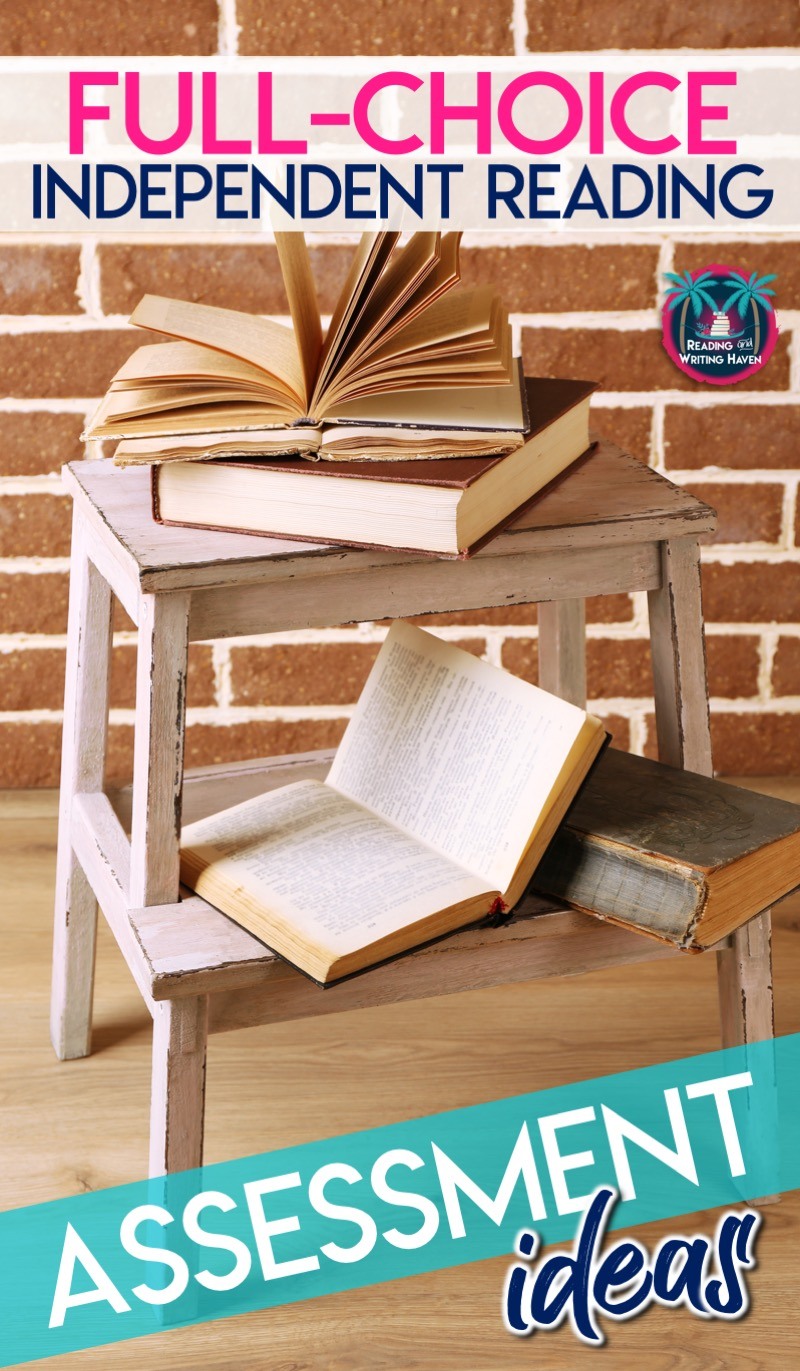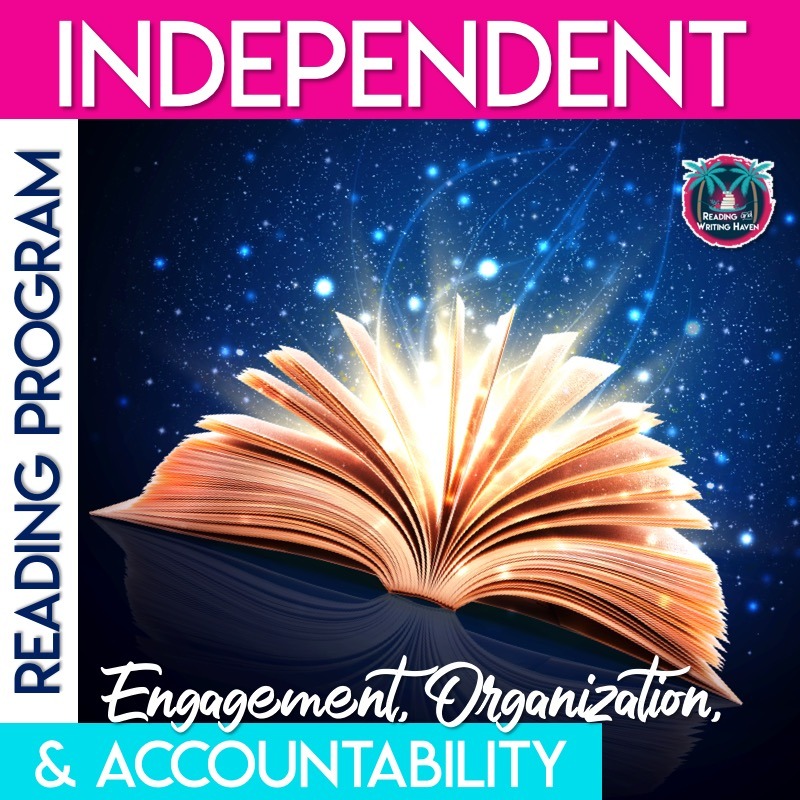Classroom Book Clubs: Independent Reading Accountability and Assessments
This post is the third in a three-part series about engaging middle and high school students in choice reading by running a book club in the classroom. Keep reading to explore some independent reading accountability ideas and assessments. Click here to begin with Part 1.
When dedicating a fair share of class time to any reading program, it’s vital to have accountability procedures in place. Students need to know how they will be assessed up front because it reassures them that although this experience as a whole is new, the teacher has a plan, and fairness will reign supreme (as much as possible, that is).
As with anything, finding assessment and accountability procedures that work for different groups of students takes time. Don’t be too hard on yourself if the first attempt flops. Just get back up, and try something new.
ASSESSMENTS AND ACCOUNTABILITY
When I first began using book clubs in my classroom, I did so because many of my students wanted to be able to read for fun without a corresponding project or essay. I empathized with them, we brainstormed, and the concept of book club seemed to be the best fit.
For a while, I allowed students to read on the honor system, and to be truthful, most of them did read. Still, I found that over time, with new groups of students, the privilege began to be abused, so I needed to implement a system of accountability. The possibilities for doing so are endless, but there are a few forms I found to be more effective than others.
ACCOUNTABILITY STRATEGIES
Independent reading accountability can come in a number of forms. As you read about each of the following options, keep in mind that the more rules we tie to independent reading, the less authentic it will be. And, the more assignments and projects we give, the less time students will spend actually reading.
Read in Class
First of all, giving students time to read in my classroom on a regular basis was one way I could track how much they were reading. If, for instance, Jack was still on page 10 after two weeks of independent reading, I knew Jack and I needed to talk. By giving students ten minutes a day to engage with their books (which is often the biggest hurdle when starting a new novel), they usually became hooked enough to want to read more outside of class.
Assign Points
Daily reading was also a way that I could assign points. Students would earn two points if they had their novel and read for the full independent reading time, 1 point if they had to go back to their locker to get it, had to be asked to read, etcetera, and no points if they refused to read or did not bring their book to class. This independent reading accountability trick is simple, quick, and doesn’t inflate the grade.
Track Reading
I’m not a big fan of reading logs, but I do like tools that help students become more aware of who they are as readers. Use a reading ladder analogy and bookshelves to help middle and high school students keep track of the difficulty level of what they are reading. Create energy around independent reading by using book spines as visible markers of class reading volume.
Conferring
Spending time talking with students about what they are reading is probably the most important form of independent reading accountability. Students often look forward to talking with their teachers about books, especially if they know they can look forward to being challenged meaningfully. As you confer, listen carefully to what students are saying, and help them set a goal to work on for the next time you meet. They can record their thinking in a reading notebook.
Written Responses
Additionally, I found periodic written responses to be not only effective but also rewarding. Occasionally, I’d give students a thought-provoking journal prompt, and they would write about their book (at least the part they had read to that point). Based upon how specific their responses were, I could fairly easily determine whether or not they were reading. If I knew for certain that one of my teens was not reading, I’d not only talk with him or her about it, but I’d also contact the parents. I’d grade their responses based on the thoughtfulness of their responses and amount of specific textual evidence they provided.
Book Commercials
Using book commercials was one of the best things I’ve ever done. Randomly, I’d call on a student (after silent reading time) to sell us their book in under one minute. Students came to expect this activity throughout the month, and because they didn’t want to look foolish in front of their peers, they read. When I called on them to give their book commercial, they’d stand and do their best job to sell their current book to their peers. This activity also gave everyone an idea of what they might want to tackle next. I assigned participation points for this impromptu activity.
Post-Reading Choices
Engaging choice assignments are another way I have been able to add a layer of accountability without it feeling like work for students to complete or for me to grade. For instance, letting students choose from a menu of fun assignment options to complete after reading the novel is usually effective. However, I don’t require these every month and have found that they work better as a quarterly or semester project.
Discussion Days
On discussion days, students talk about all of the different books they have read. I provide discussion question task cards, and they create their own questions to extend the conversation as they talk. During this time, I informally quiz students. I walk around, listen to conversations, and ask students questions about their novels. I find it’s pretty clear which students read the book and which don’t based on their ability to talk about the novel intelligently.
Let Go
But. Here’s the thing. I am very cautious to assign an overall grade with book clubs because no matter how hard we try, we’ll never know whether or not Betty read every single word in the book. And, we don’t want to squelch students’ love for reading. It shouldn’t feel like an “I gotcha!” It should feel encouraging, enjoyable, rewarding, and fulfilling. In other words, I had to loosen the reigns on my Type A control-oriented teacher personality and realize that it’s okay if a couple get away…as long as the majority are learning to fly.
THE ROLE OF THE TEACHER
Sometimes when every student is reading a different book, it can be a little uncomfortable for the teacher. If we aren’t the sage on the stage, what are we supposed to be doing? Here are some independent reading accountability tips for the teacher.
Confer
While students read independently, spend time meeting with students one-on-one to listen and set goals. At first, get to know your readers. Here are some conferring questions you can use to guide conversations. Then, start helping them identify goals and giving them strategies they can use when reading independently. Also, meet with small groups of students to practice applying class lessons to independent reading. For instance, if you are working on reading strategies, sign posts, or specific reading literature standards, choose one, and find out how the students in the group are doing with applying that concept to their reading.
Model
Students need to see you reading because it impresses upon them the fact that you make time for it. It’s a part of your lifestyle. It’s not just a school assignment from which teachers are exempt. Make book recommendations and give book talks.
Read Aloud
Read high-interest texts out loud to students. As you do, model your thinking. Demonstrate how you use reading strategies and how you think about the interaction of literary elements. Tie these whole-class mini lessons into your reading conferences.
Encourage
Motivate your students. Encourage them. Rachel, I saw how far you are in your book. That’s amazing! I can’t wait to talk to you about it. What will you be reading next? You’re really on fire this month! … or perhaps … Jackson, I am so proud of you for taking your book with you to other classes. I saw you reading with your extra time after gym yesterday. That really shows maturity on your part.
Participate
When students are talking about the books they are reading, jump in! After silent reading time, volunteer some information about your book — tell them what you love about it, summarize the part you just read, analyze an author’s literary term usage in a particular passage, tell them what you predict will happen next. Then, invite them to share something they just read.
Build Rapport
Showing interest in the type of books your students enjoy will help you to establish a deeper relationship with a higher level of trust. If, for instance, one of your students wants you to read Harry Potter (but you hate Harry Potter), read enough of it to talk to them about it. They will eat. it. up. And, they will be much more receptive to your recommendations, which might be outside of their comfort zones.
Play Matchmaker
So. We all have those teenagers who just don’t want to read anything. Nothing we say is going to motivate them (or so they think). Sometimes that might be the case, but it’s important to give it the good old college try. Use what you know about them and what they wrote on their reading interest inventory to make book suggestions. As a last-ditch effort, find something they haven’t hated reading in the past, and let them begin their book club experience by rereading it.
Be Flexible
The thing about book club is that when every student is reading a different novel, it gets a little messy. It’s impossible to give multiple choice quizzes over 150 different books. So. We need to keep in mind that the purpose is to encourage students to love reading, and we need to stay positive.
We need to remember that when we read a book, we might not finish every page. When we were in college, we most likely didn’t read every assignment we were supposed to read. Does that mean we didn’t deserve our degree? No! It means we need to be empathetic and give our students some breathing room.
We need to encourage them, monitor them, offer them choices, motivate them, and communicate with their parents, but we can’t stress out about whether or not every child is reading every page. It’s not healthy. It’s not the point. And, it undermines our goal.
Recognize that students are taking ownership! On many current teacher evaluation forms, administrators want to see that students are taking ownership in their own learning. Book club is a perfect avenue for them to do that. Make sure your administration knows just how hard you’re working on getting students to take responsibility for their own learning through your student-run book club format.
Independent reading, when time is used wisely, is one of the greatest gifts we can give our students. However, independent reading accountability and assessment can be challenging. What questions or suggestions do you have about making it work?
RELATED RESOURCE:
Click on the images below to view some of the independent reading accountability resources I love using when I implement a book club in the classroom.


